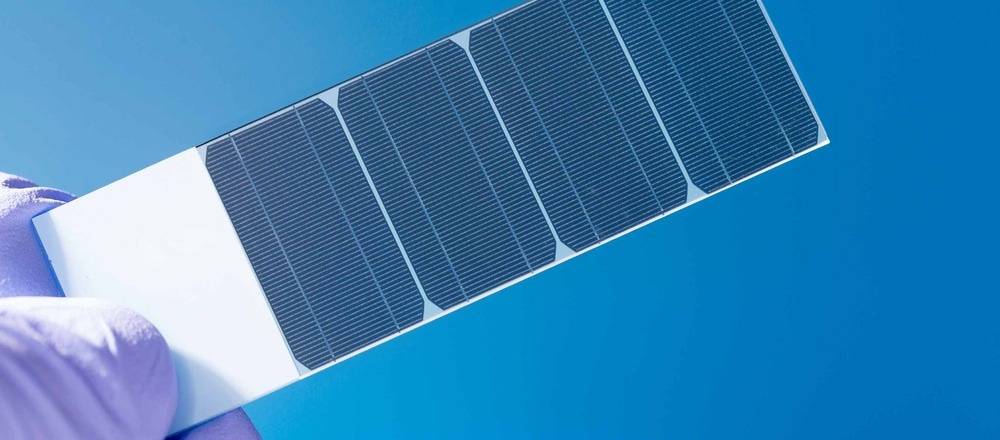Efficiency deterioration is a significant problem associated with cadmium sulfide/tin monosulfide (CdS/SnS) solar cells, hindering their practical applications. A pre-proof paper from the Journal of Alloys and Compounds addresses this problem by manipulating the photovoltaic properties of a CdS/SnS solar cell using the plasmonic effect of silver and gold nanoparticles.

Study: Overcoming the poor performance of n-CdS/p-SnS solar cells by plasmonic effect of gold and silver nanoparticles. Image Credit: luchschenF/Shutterstock.com
Development of Solar Cell Technology: An Overview
Researchers are focusing on making novel substances with high photonic absorption for use in thin-film photovoltaic cells. Solar cell technology is an excellent and innovative energy source, with the field constantly and rapidly developing worldwide.
Many semiconductors, like tellurium, indium, and gallium, have good photovoltaic characteristics and high-power conversion efficiency (PCE), making them ideal materials for next-generation solar cell technology. However, the cytotoxicity of tellurium and the lack of natural resources of gallium and indium severely restrict their applicability for fabricating a low-cost solar cell.
CdS/SnS Cells: The Future of Solar Cell Technology
The cadmium sulfide/tin monosulfide (CdS/SnS) solar cell is an exciting photovoltaic device with remarkable electronic properties. Because of its flexibility and simplicity of production, the combination of p-type tin monosulfide and n-type cadmium sulfide has recently received significant attention for energy storage applications.
Tin monosulfide (SnS) is a non-toxic, low-cost p-type semiconductor having both direct and indirect photovoltaic gaps. SnS has good electric and optical characteristics, including high absorbance coefficients, high charge transport, and minimal recombination rates. Furthermore, the mechanical and electrical characteristics of SnS thin films are tuneable to the deposition process, making them a suitable material for low-cost solar cell fabrication.
On the other hand, cadmium sulfide (CdS) is a unique material with a structurally dependent energy bandgap frequently employed in photoelectric and photodetection systems. The effectiveness of CdS stems from its spectrum tunability, charge carrier diffusion length, and excellent photocatalytic activity. In addition, the role of CdS in the passivation of implanted p-type films in many optoelectronics cannot be neglected.
A Novel Approach for Enhancing the Efficiency of CdS/SnS Solar Cell
CdS/SnS heterostructures have poor photocatalytic activity due to electron affinity anomalies, secondary phase development, and film thickness incompatibility. Furthermore, the energy imbalances between the valance band and conductance band of SnS and CdS reduce the shunt resistance of the CdS/SnS solar cell and the lifetime of charge carriers.
Surface plasmonic resonance is a potent and efficient method for increasing the absorption characteristics of the coated active layer and the overall efficiency of the CdS/SnS solar cell. Localized surface plasmonic vibrations associated with the incoming electromagnetic field increase absorbance cross-section by capturing incident light in the active region and enabling charge carrier segregation.
Because of their tuneable plasmonic absorbance and oxide-free nature, silver and gold nanostructures are the most commonly used components in plasmonic augmented optoelectronic devices and solar cell systems.
Highlights of the Current Study
In this study, the researchers improved the photovoltaic efficiency of a CdS/SnS heterojunction solar cell by spin-coating it with silver and gold nanoparticles. The researchers also examined how silver and gold nanoparticles affected the physical, electrical, and photonic characteristics of the CdS/SnS solar cell.
The crystallographic investigations of the deposited CdS, SnS, and the heterojunction solar cell with and without the decoration of nanoparticles were performed using the X-Ray diffraction technique. The morphology of the heterojunction layers and the nanoparticles' distribution was evaluated using a scanning electron microscope (SEM).
Important Findings
The researchers noticed a pronounced influence of the silver and gold nanoparticles on the absorption performance and the overall efficiency of the CdS/SnS solar cell. The gold nanoparticles improved the efficiency of the virgin CdS/SnS solar cell from 0.022-0.066% to 0.436-0.51%, while the silver nanoparticles decorated cell achieved an even better efficiency of 2.507- 4.363%.
This improvement is obtained because the plasmonic activity of the nanoparticles enhances the concentration of photoinduced charge carriers in the CdS/SnS heterostructure by increasing absorption events and inhibiting the recombination events. The efficiencies attained in this work set a new benchmark for CdS/SnS-based photovoltaic cells, making them a viable contender in the solar cell and photodiode industries.
Reference
El-Mahalawy, A. M. et al. (2022). Overcoming the poor performance of n-CdS/p-SnS solar cells by the plasmonic effect of gold and silver nanoparticles. Journal of Alloys and Compounds. Available at: https://www.sciencedirect.com/science/article/pii/S0925838822028754?via%3Dihub
Disclaimer: The views expressed here are those of the author expressed in their private capacity and do not necessarily represent the views of AZoM.com Limited T/A AZoNetwork the owner and operator of this website. This disclaimer forms part of the Terms and conditions of use of this website.